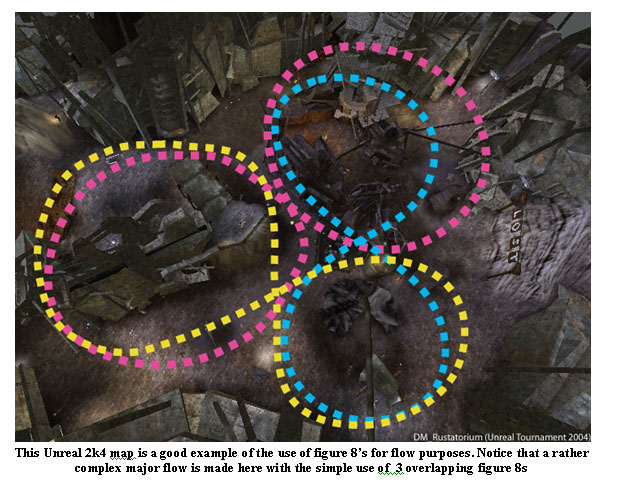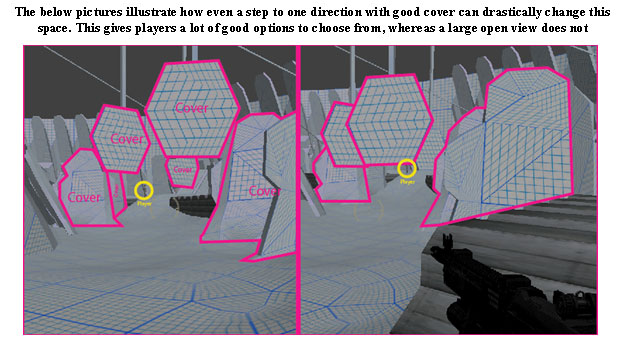An Overview: What is Fun About FPS Multiplayer?
Choices
Sid Meyer once said that “a game is a series of interesting choices” and nowhere in game design is this more true than Multiplayer Design. In a single player game, the designer has access to design tools to help guide the player, like linear progression, or even just general good crafting of gameplay segments. In a multiplayer game, the player is constantly having to make his own experience using only the tools you provide him to do so.
As such, it is important to approach multiplayer map design from this perspective: Provide the player with good tools and he can create a good experience.
All this sounds blaringly obvious, of course, but given how many people get this basic tenet wrong it deserves stating.
Terrain Options
One good way to provide players with interesting choices in a multiplayer FPS map is to give them a variety of terrain options to choose from. (Elements like walls, cover, high ground, and low ground are all examples of these terrain options.) Good players learn what terrain to use depending on the situation – for example, it’s usually just a better idea for a player to have higher ground than his opponent. Not only does it provide him with an excellent angle to fire at them with, it also usually provides partial cover. Now lets say you place the high ground near a wall – now the player has a choice to make: Does he go for the high ground and attempt to get cover, or does he stay in the open to avoid getting hit easily with a splash damage weapon?
A good multiplayer designer is always thinking of terrain options and trying to engineer them to provide as many good choices for the player as possible.
Multiple Paths
In single player games, it is often beneficial to lead the player towards the best gameplay experience your game has to offer. Often, this leads to a linear level design (which is, in most cases, best suited to the experience you want to provide). In multiplayer a linear path is rarely beneficial. A good player is constantly varying his route through a level, sometimes to shake off pursuers or sometimes in order to go after desirable weapons or pickups. Either way, it is always advantageous for the player to have a number of paths to get to and from every major area in a multiplayer map. As a general rule, a good multiplayer design should strive to make sure all major areas have at least three ways in and/or out of them. As with all rules, there are exceptions — and I’ll get into those in future installments.
Flow
In addition to multiple paths, a good multiplayer level designer is constantly thinking of how he wants the players to move globally through a multiplayer map. This level of understanding, called flow, affects everything from pickup placement in a deathmatch map to node placement in a node-capture map.
It is often beneficial for a designer to come up with a rough bubble diagram before attacking the level. Such a diagram will usually just consist of simple shapes (circles, squares, triangles) representing major areas. Once you’ve got a nice area layout, you connect them with arrows showing the different ways in or out of that area. Then you start to think about how you want a player to travel from one area to the next and where the points of interest are on that path. If you’re ever having trouble coming up with a good flow, there are several default shapes that you can always fall back on that work almost every time.
The Circle
A circle is the simplest kind of flow a level could have. While you would almost never design a level that only flowed in a circle, sometimes you can define your major flow path as a simple circuit through the level. This is often a good springboard that gets you thinking about even better flows.
The Figure 8
If you play any competitive multiplayer games (most often FPSs) you will notice that a lot of levels are based off the simple figure 8. Figure 8’s are a very interesting shape for major flow. While they offer all the benefits of a circle, as far as providing interesting flow, they also have the added benefit of an additional major flow path that cuts through half the circumference of the circle.
Often, you can get incredibly involved and complex flows out of a few well-placed figure-8s.
Interesting Spaces
Focal Points
Focal points are a particularly important feature of multiplayer maps. Not only do they divide up the players’ interest to many different points on the map, they also provide areas of visual interest. Every well designed map will contain a focal point at the most important point on the map (usually the center) as well as minor focus points in every major area.
Examples of focal points include really tall structures, interesting terrain formations, gameplay-required elements (such as nodes), pickups, and anything that adds particular visual interest to an area.
Verticality
The terrain options section touched on this a little bit, but verticality’s importance in multiplayer design can not be overstated. Verticality increases the amount of player choices in an area, but also increases the “gameplay per square meter” that a map has. A completely flat map that supports 32 players might be 400m x 400m, but you could fit the same number of players into a 200×200 map just by adding one or two levels of verticality to all the major areas on a map.
In Resistance, for example, we found that adding verticality to a space in 3 meter increments (specifically 3 and 6 meter height differences up or down) made our spaces much more interesting and allowed them to be a lot denser and generally more fun.
Cover
It’s important in multiplayer that your players not be able to shoot too far ahead of themselves most of the time. Large open spaces should usually be broken up with a lot of full cover. This also allows players to advance through areas without being vulnerable for too long. The exception to this rule is any area where you want to encourage a risk/reward scenario (for example, with a large open space with lots of cover on the outskirts and a nice powerup in the center the player is encouraged to take a risk and get the powerup with the possibility that someone might shoot at them from the well-covered spots.) We’ll get more into risk/reward scenarios in future installments.
Next installment: Designing FPS Multiplayer Maps – Part 2…


I think I know what comes next. Getting headshot-ed over and over and over again.